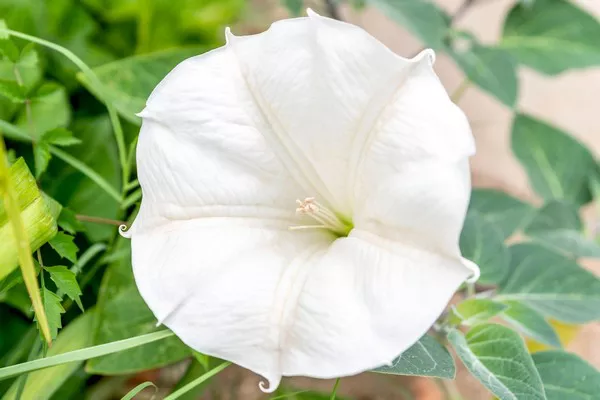Moonflowers, scientifically known as Ipomoea alba, are enchanting night-blooming plants renowned for their stunning appearance and captivating fragrance. These elegant vines, native to the Americas, unfurl their large, white, trumpet-shaped blossoms under the cover of darkness, releasing a captivating scent that has fascinated plant enthusiasts and gardeners for centuries.
The Botanical Beauty of Moonflowers
Moonflowers belong to the Convolvulaceae family, which includes morning glories. These perennial climbers are characterized by their heart-shaped leaves, reaching lengths of up to 15 centimeters (6 inches), and large, fragrant flowers that can span 15 to 20 centimeters (6 to 8 inches) in diameter. Moonflower blossoms open in the evening, typically after dusk, and exude their captivating scent throughout the night.
A Heavenly Fragrance
One of the most intriguing aspects of moonflowers is their heavenly fragrance. Their scent is often described as both ethereal and intoxicating, evoking a sense of romance and mystique. The aroma is most pronounced during the nighttime when the flowers are in full bloom, attracting moths, which are their primary pollinators.
The fragrance of moonflowers can vary slightly from plant to plant, but it is generally characterized by the following olfactory notes:
Sweetness: Moonflowers emit a sweet, delicate aroma that is often compared to the scent of vanilla or honey. This sweetness is subtle but alluring, making it a popular choice for those who appreciate soft, floral fragrances.
Floral Undertones: Underlying the sweetness, there are distinct floral undertones in the moonflower’s scent. These hints of jasmine, lily, and gardenia add depth and complexity to the fragrance.
Nighttime Allure: Moonflowers release their fragrance primarily at night, creating an aura of enchantment and mystique. This nocturnal quality adds to the allure of the scent.
Cultural Significance of Moonflower Fragrance
Throughout history, moonflowers have held a special place in various cultures and have often been associated with profound symbolism and meaning. Their fragrance has played a significant role in these cultural contexts:
Romantic Symbolism: Moonflowers are often linked to romance and love. Their enchanting fragrance, combined with their nocturnal blooming, has led to their association with love that blooms in the darkness. In some cultures, moonflowers are considered tokens of affection and devotion.
Spiritual and Mystical Significance: In certain belief systems, moonflowers are believed to possess mystical and spiritual qualities. Their night-blooming nature and captivating scent have been used in rituals, meditations, and ceremonies to connect with the divine or access hidden wisdom.
Poetic Inspiration: The fragrance of moonflowers has inspired poets and writers to evoke the allure of the night and the mysteries it holds. The soft, sweet scent of moonflowers has been a muse for countless creative works.
The Science Behind Moonflower Scent
Understanding the chemistry of moonflower scent adds a layer of fascination to these captivating blossoms. The fragrance of moonflowers is produced by volatile organic compounds (VOCs), which are released by the petals and become airborne. The primary VOCs responsible for moonflower scent are:
Benzyl Alcohol: This compound contributes to the sweet, floral, and slightly fruity notes of moonflower fragrance.
Phenylacetaldehyde: Known for its rose-like scent, phenylacetaldehyde adds a delicate floral undertone to the fragrance.
Methyl Benzoate: Methyl benzoate is responsible for the fruity, sweet nuances in the scent of moonflowers.
The blend of these VOCs creates the unique and enchanting scent that moonflowers are renowned for. However, it’s important to note that the intensity of the fragrance can vary among moonflower varieties and individual plants, and environmental factors such as temperature and humidity can also influence the strength of the scent.
Gardening Moonflowers for Fragrance
Growing moonflowers in your garden can provide you with the opportunity to enjoy their exquisite fragrance first-hand. Here are some tips for successfully cultivating moonflowers:
Planting: Moonflowers can be grown from seeds. Start by soaking the seeds in warm water for 24 hours before planting them in well-draining soil. Place them in a sunny location with plenty of direct sunlight.
Support: Moonflowers are climbing vines and need support to grow. Install a trellis, arbor, or fence for them to climb on.
Watering: Keep the soil consistently moist but not waterlogged. Water in the morning to ensure the foliage has time to dry before evening, reducing the risk of fungal diseases.
Pruning: Regularly prune moonflowers to encourage bushier growth and more abundant flowering.
Fertilization: Use a balanced, all-purpose fertilizer sparingly to avoid overstimulating foliage growth at the expense of blossoms.
Pollination: Moonflowers rely on moths for pollination. If you want to enjoy the fragrance and the eventual formation of seeds, avoid using pesticides that may harm these important pollinators.
Harvesting Moonflower Seeds
If you wish to harvest moonflower seeds for future plantings or to share with others, follow these steps:
Seed Pod Development: Moonflowers produce large, spherical seed pods that develop after the blossoms fade. Allow these seed pods to mature and turn brown on the plant.
Harvesting: Carefully cut the seed pods from the plant when they are fully mature. Be gentle to avoid damaging the seeds.
Seed Extraction: Break open the seed pods and extract the flat, dark brown or black moonflower seeds. Store them in a cool, dry place until you’re ready to plant them.
Conclusion
The captivating fragrance of moonflowers is a testament to the wonders of the natural world. Their sweet, floral, and nocturnal aroma has inspired countless individuals, from poets and writers to gardeners and lovers. Whether you choose to grow moonflowers for their scent, their symbolism, or their sheer beauty, they are a delightful addition to any garden. As you cultivate these enchanting vines, you will discover that the true magic of moonflowers lies not only in their scent but in the mystical ambiance they bring to your garden under the light of the moon.

